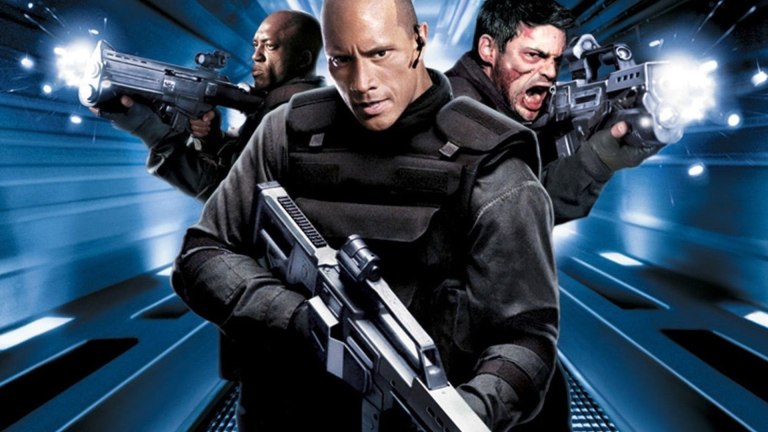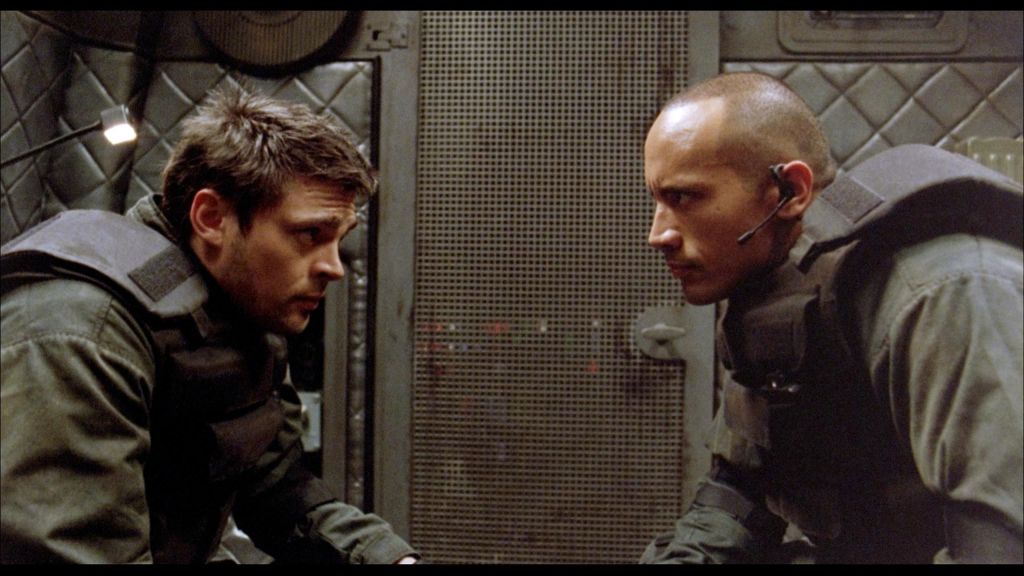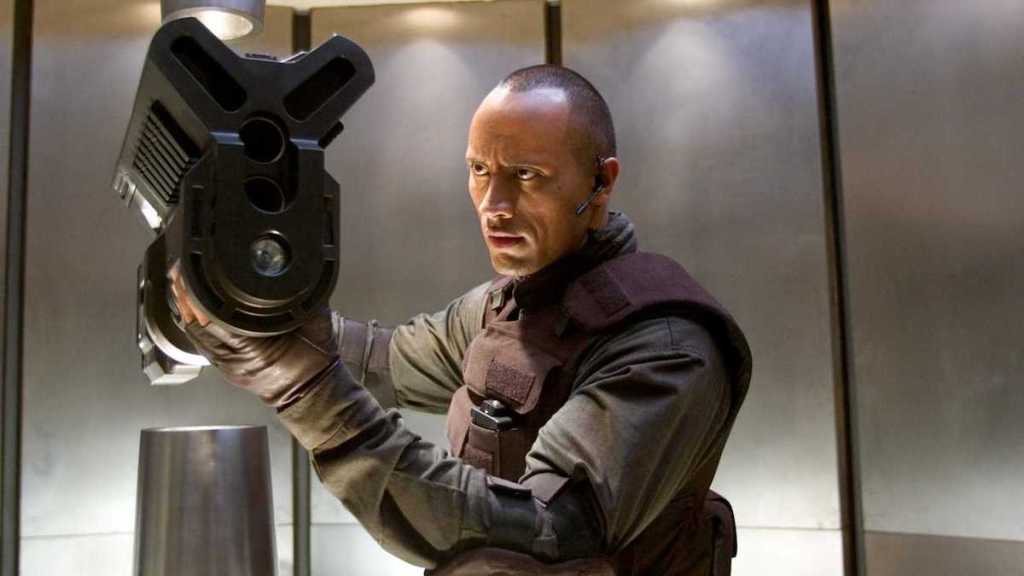What Went Wrong With Dwayne Johnson’s Doom Movie?
A video game movie starring Dwayne Johnson should have been gold, but Doom couldn't break the curse. Screenwriter Wesley Strick tells us what went wrong.

When Dwayne “The Rock” Johnson took to the stage at the Amway Arena in Orlando, Florida on March 29, 2008, few could have predicted what would come next.
The budding action star was there to induct his father and grandfather into the WWE Hall of Fame, however, at times, his speech felt more like an impromptu comedy roast.
“There was big controversy with the WWE and illegal torture,” one convoluted gag began. “Apparently they would find Iraqi insurgents, tie them up and make them watch DVD copies of The Marine.”
John Cena, who starred in The Marine, was in the audience that night and took the ribbing in good humor, with his exaggerated on-camera reaction spawning what would come to be known as the “John Cena oh s**t gif”.
Johnson wasn’t finished though.
“By the way I made Doom. Did you ever see Doom? Well, you probably didn’t and it’s okay because nobody else did either.”
Cue laughter.
Nearly three years on from its release, The Rock could finally laugh about Doom. No one had been laughing when the film first debuted in October 2005 to rank reviews and a poor box office return.
Film critic Richard Roeper was among those to tear into the film.
“The performances are awful, the action sequences are impossible to follow, the violence is gratuitous, the lighting is bad and I have my doubts that the catering truck was even up to snuff.”
He had a point.
Largely filmed in a series of identical-looking and poorly lit corridors of a generic space station, Doom had the look and feel of a bad Alien knock-off. Worse still, it bore almost no resemblance to the source material.
Johnson may be the biggest film star in the world today but back then he was still just another wrestler trying to make the leap into movies. In truth, he was fortunate that Doom didn’t torpedo his chances in the way countless misfiring movies had for other aspiring wrestlers-turned-actors.
So where did it all go wrong?
Arnold Schwarzenegger and ILM
Film adaptations of popular video games are famously fraught with difficulties.
You could probably count the number of good video game movies on one finger – Paul W.S. Anderson’s Mortal Kombat, before you ask.
But id Software, the developers behind the pioneering Doom franchise, had been hopeful of bucking the trend back in 1994 when Universal first purchased the film rights.
“I think Doom would be easier to write a script for than, say, Street Fighter,” business manager and co-owner Jay Wilbur told PC Gamer.
Wilbur’s vision for the movie certainly sounded appealing.
“I see Arnold Schwarzenegger with all the Doom garb on, Industrial Light & Magic supplying the special effects and the story would be something along the lines of Arnie stationed on Mars when the dimensional gateway opens up and demons flood in…So everybody’s dead – well maybe not everybody, you need a little human interaction and comic relief going on. But mainly, just non-stop seat-of-your-pants sweat-of-your-brow action.”
Fusing elements of Commando, Total Recall, and the later Arnie effort End of Days, Wilbur’s sketch of a Doom movie sounded perfect – but there were issues from the start.
According to former CEO Todd Hollenshead, several potential scripts were vetoed by id Software for failing to stay true to the source material. While Schwarzenegger was approached, plans for the project were ultimately shelved in the wake of the Columbine High School massacre and negative press it generated around the game.
Doomed Casting

It would be almost a decade before interest in a movie version would be rekindled by producers Lorenzo di Bonaventura and John Wells, who obtained the rights after footage from Doom 3 was shopped to agents from Creative Artists Agency.
Di Bonaventura enlisted David Callaham, then a novice writer in Hollywood, to pen a script based loosely on a handful of ideas he had pitched during a chance meeting.
Schwarzenegger, by then, was not only significantly older but also busy as Governor of California. Alternatives were explored. One rumor, neither confirmed nor denied, suggests Vin Diesel was in the frame to star. Ultimately, however, it was Johnson who ended up landing top billing.
Not that anyone was complaining. Johnson was largely a B-movie star up until that point, making Doom a good fit to potentially take him into the big leagues. There was just one problem though – The Rock didn’t want to play the good guy.
Producers had originally slated the WWE star to play the film’s main protagonist, Staff Sgt. John “Reaper” Grimm. Johnson had other ideas, though.
“When I first read the script, and read it for [the part of] John, after I read it I thought wow John is a great character and, of course, the hero of the movie,” Johnson explained at the 2005 San Diego Comic-Con. “But for some reason I was drawn more to Sarge, I thought Sarge was, to me, more interesting and had a darker side.”
He agreed to star but only in the role of Sarge, leader of the film’s Rapid Response Tactical Squad sent to Mars and someone who ends up becoming the principal villain.
Karl Urban, fresh from featuring in the Lord of the Rings trilogy, was cast in his place in what represented the first major misstep.
Watching the film back now, it’s tempting to wonder whether Doom might have fared better had the two switched roles.
After all, Johnson has carved a sizeable niche as an all-American good guy in the years since, while roles in Dredd and The Boys highlighted a darker streak to Urban’s repertoire.
It’s certainly something Wesley Strick, who served as script doctor and ultimately co-writer on the film, concurs with when the notion is put to him.
“That would work better,” he tells Den of Geek. “I think you are onto something there. The swap was his idea though and this is all with hindsight.”
Blame Superman
An experienced screenwriter with credits on Arachnophobia and Martin Scorsese’s Cape Fear, Strick ended up working on Doom as an indirect result of Tim Burton’s failed Superman movie.
“Lorenzo [di Bonaventura] was head of production at Warner Bros when Tim Burton asked me to come onboard for Superman Lives,” Strick explains.
“Tim and I and Nicolas Cage cooked up this whole scenario for a Superman movie and we would often walk into Lorenzo’s office to do battle with him, essentially, because he was stubbornly opposed to almost every idea we had,” Strick says. “Consequently, Lorenzo and I really butted heads and sometimes it could get quite ugly…I felt like I might have burned my bridges.”
With Superman years in the past, di Bonaventura called Strick to gauge his interest about working on Doom.
“I really wasn’t interested,” Strick says. “Just because I knew nothing about the game. But I have two sons and they were teenagers so there was a lot of enthusiasm from them. They told me to look into it and were excited about the idea of their dad working on this video game movie. Any project you can do where your kids are involved and excited is fun. So that appealed to me.”
Strick was also sold on the film’s director, an exciting young Irish filmmaker called Enda McCallion. McCallion had made his name with a series of striking TV adverts (the Metz alcopop ‘Judderman’ campaign) and music videos for the likes of Nine Inch Nails.
He was being tipped to follow in the footsteps of filmmakers like Jonathan Glazer by transitioning into features.
“Enda was this up-and-coming new Irish director who was hyped to me as a visionary and someone who was going to bring something very original to the movie. It wasn’t going to just be this piece of product.”

Big picture stuff
Strick was tasked with simplifying Callaham’s script to ensure it translated into a workable schedule and, crucially, that it could be made within a modest budget of $60–70 million. That meant cuts.
“The producers looked at it and tried to put together a schedule and realized it was too complicated,” Strick says. “So, I read it and came up with a simple solution. In Callaham’s draft the marines kept going back and forth through this portal. Three times or something. It was unnecessary. They would go over there and then chase back and then regroup and then return to Mars or whatever. I said no, do it once and be done with it. I also had a list of a couple of monsters I thought the movie could do without.”
The decision to cut several monsters familiar to Doom enthusiasts was a contentious one among fans, with Callaham’s original script featuring both the Cacodemon and Arch-Vile among others. Strick had been through this kind of process before though.
“This is sort of the big picture stuff,” he says. “You can get a lot of shit from fans when they feel like you are trespassing on their genre and I think that happened to an extent on Doom. People were like ‘how dare you’.”
He cites his experience on Batman Returns as an example of when the fanboys miss the point.
“I hadn’t read a comic book since I was 12 and I loved them but I was 37 then,” he says. “Way past comic book age. In my mind, that’s okay because you’re trying to write a movie, not a comic book. You don’t want a comic book fanatic on a job like that – what would they bring to the movie?”
Despite ringing the changes, one sequence Strick was determined to retain from Callaham’s script was the five-minute first-person shooter sequence.
“That was one bit I wanted to keep in no matter what. It was just funny. It had a great attitude and visually it was just delightful. If anyone ever proposed cutting it, I would argue strenuously against that. It was a great idea. Real, in your face.”
All Change
By the time filming commenced in Prague in the winter of 2004, however, Strick found himself working on a very different film. McCallion had departed the project for reasons unknown. He didn’t respond to our request for an interview.
In his place came Andrzej Bartkowiak, a seasoned cinematographer who had recently branched out into directing in the early 2000s, helming a trio of Jet Li action movies.
“I was deeply disappointed when Enda left the project,” Strick admits. “It became the thing that I was assured of at the beginning it wouldn’t be. A more conventional approach to a movie like that. I don’t know what kind of movie Enda would have made but at least there was the possibility with him that it was going to be something special.”
Strick was also having to contend with issues elsewhere.
“When Doom moved to Universal, a guy called Greg Silverman became my executive on the project and he didn’t like me. He just always gave me shit,” Strick says. “Once he told me everything I had portrayed about the marines and their tactics was inauthentic. He wanted real, genuine, marine combat tactics. I went back and did loads of research, read books like Jarhead, and really immersed myself in the whole marine mindset. I did a rewrite where I fixed all of the combat stuff, so it was genuine US marine combat protocol. And he hated it. I tried to explain that was exactly what was happening in Iraq, but he was just like ‘nah’. So we ended up going back to the fake stuff.”
It’s an anecdote that hints at that dreaded but all too familiar issue on disjointed projects of this kind – studio interference – and Strick wasn’t the only one experiencing frustration. In the run-up to the film’s release, his co-writer Callaham had begun interacting with angry Doom fans online, who had heard rumors of the film taking liberties with the source material.
Writing in a lengthy open letter defending his screenplay, the young writer managed to make things worse.
“Let me assure you…, that the themes and elements that you love about Doom are ALL represented strongly in the film…just with some new twists,” he wrote.
Few were convinced, however, particularly after he went on to claim he had watched a “bunch of strangers bastardize” his original vision of the film.
Strick has some sympathy.
“As soon as you engage in a fight on the internet, you’ve lost. I don’t think Dave realized that until it happened, but he got the shit kicked out of him by Doom fans. He was determined to defend himself and his movie against all comers and they just kicked him around. But he got back up and got moving again.”
Callaham certainly did that, going on to pen The Expendables and, most recently, Wonder Woman 1984.
Strick remains philosophical about his experience on Doom and still has cherished memories of taking his sons to the premiere [“they were in awe of The Rock” ].
Positives and Negatives
“I thought the film was pretty good. Particularly in the sequence where it becomes like the video game. It’s the one great thing in the movie. Ironically, it’s a movie but it’s at its best when it devolves into pure video game action.”
Bartkowiak took the brunt of the criticism for the film’s visual issues – visual effects wiz Jon Farhat took charge of the much-lauded first-person shooter sequence.
Things would get even worse for the experienced cinematographer-turned-director a few years later with his next film, Street Fighter: The Legend of Chun-Li, which pulled off the ignominious feat of being an even worse video game movie.
Johnson rode the storm though, eventually hitting A-lister pay dirt with 2011’s Fast Five – a movie that breathed new life into his career and the Fast & Furious franchise as a whole.
Today, Johnson is able to laugh about Doom, recently claiming its failure was the result of a “video game curse” he successfully broke with Rampage. The jury is still out on that one.
With a different director, more ambitious budget and the right stars in the right roles, Doom could well have ended up being a great video game movie – but Strick thinks making a truly great video game movie “is next to impossible.”
It’s about narrative,” he explains. “In a movie, we’re taking you for a ride whereas in a video game you are in the driving seat. So they are two conflicting and competing ideas for what makes a story engaging. Sit back, relax, we’re going to entertain you versus you’re immersed in an environment that you control. I don’t know where you find the center for that where the two opposing ideas co-exist. That’s possibly why the video game sequence is so good. It took on that paradox. You’re watching a video game movie that’s a simulation. It’s a kind of reminder of what the movie could never be.”